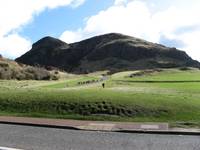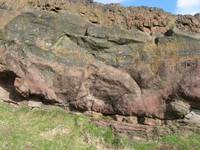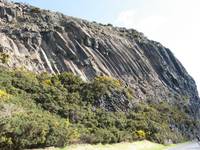Inspiring geology at Arthur’s Seat
May 2nd, 2010 at 4:29 pm (Geology)
Edinburgh is where James Hutton delivered his landmark lectures claiming not only that the Earth was older than the then-accepted 6,000 years, but that it was “immeasurably old” given the tools available in that time (1785). (How he would have loved to have lived to the invention of radiometric dating!) Hutton was a great observer, taking careful note of the impact of regular daily erosional processes, and what they could do if extended out over aeons. He also traveled around much of Scotland and England examining interesting rock formations.
His careful observations inspired him to suggest the radical idea that molten rock from deep underground could force its way up through overlying, older sedimentary layers. (At the time, sedimentary rock was held to be the youngest rock type, as all existent rocks were believed to have precipitated out of a global ocean.) One of the formations that supported his claim is “Hutton’s Section”, lying at the base of Arthur’s Seat, just outside of Edinburgh. Naturally this was one of the highest priorities on my sights-to-see list!
 Arthur’s Seat is the remnant of a volcano that erupted about 340 million years ago (see Arthur’s Seat’s formation history in sketch format). Edinburgh Castle is built on another volcanic remnant nearby. It’s a good climb up to the top of Arthur’s Seat (823 feet high), which affords an excellent view of the surrounding country. (It was gaspingly windy, although sunny, the day I climbed it, and people and dogs were stumbling around at the top, buffeted by the wind.) But one doesn’t see much geology from up on top of anything!
Arthur’s Seat is the remnant of a volcano that erupted about 340 million years ago (see Arthur’s Seat’s formation history in sketch format). Edinburgh Castle is built on another volcanic remnant nearby. It’s a good climb up to the top of Arthur’s Seat (823 feet high), which affords an excellent view of the surrounding country. (It was gaspingly windy, although sunny, the day I climbed it, and people and dogs were stumbling around at the top, buffeted by the wind.) But one doesn’t see much geology from up on top of anything!
 I found Hutton’s Section near the dip between Arthur’s Seat and the Salisbury Crags. The Crags are a volcanic sill, composed of lava that pushed its way out from the volcano’s main chamber to spread horizontally through the sedimentary layers. At Hutton’s Section, you can see a blob of volcanic rock intruding right into a sedimentary layer—from above. (See also the University of Edinburgh’s photo and description of the Section). I felt a moment of quiet, powerful awe as I stood in the same spot where Hutton had stood, seeing almost with his very eyes. (But would I have been able to interpret this evidence as ably as he did?) Later in the day, as I walked around to the north side of the Crags, I could see that there were several places where this same phenomenon occurs, not just at his Section. Repeatability lends credence!
I found Hutton’s Section near the dip between Arthur’s Seat and the Salisbury Crags. The Crags are a volcanic sill, composed of lava that pushed its way out from the volcano’s main chamber to spread horizontally through the sedimentary layers. At Hutton’s Section, you can see a blob of volcanic rock intruding right into a sedimentary layer—from above. (See also the University of Edinburgh’s photo and description of the Section). I felt a moment of quiet, powerful awe as I stood in the same spot where Hutton had stood, seeing almost with his very eyes. (But would I have been able to interpret this evidence as ably as he did?) Later in the day, as I walked around to the north side of the Crags, I could see that there were several places where this same phenomenon occurs, not just at his Section. Repeatability lends credence!
 Another stunning geological sight at Arthur’s Seat is Samson’s Ribs, a sprawling cliff on the Seat’s southwest side composed of huge basaltic columns. Such geometric (hexagonal) construction always arrests the eye, since it seems so artificially precise and angular. Yet the crystal formation processes that lead to these structures are quite natural, and the size of the columns provides clues as to the rate at which the magma cooled and formed them.
Another stunning geological sight at Arthur’s Seat is Samson’s Ribs, a sprawling cliff on the Seat’s southwest side composed of huge basaltic columns. Such geometric (hexagonal) construction always arrests the eye, since it seems so artificially precise and angular. Yet the crystal formation processes that lead to these structures are quite natural, and the size of the columns provides clues as to the rate at which the magma cooled and formed them.
If you ever get a chance, do stop and see these beautiful structures! And pick up some geocaches while you’re there: Weir’s Way: An Edinburgh Volcano, Arthur’s Seat Earthcache, Let’s Get Radical, and Samson’s Ribs Earthcache. For more information on James Hutton and his contributions to founding geology as a science, I recommend The Man Who Found Time, a book that served as a delightful in-country guide and provided all sorts of fascinating background on Hutton and his insights.
Susan said,
May 5, 2010 at 8:36 pm
Wow! We climbed Arthur’s Seat while we were there and had a grand old time, but I had no idea its geological significance!